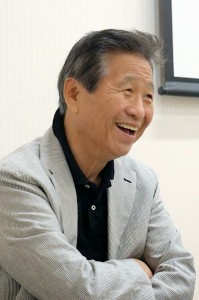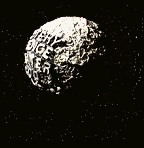 Koichi Kawakita, former head of the special effects department at Toho Studios, died from liver failure on Dec. 5, 2014, his 72nd birthday.
Koichi Kawakita, former head of the special effects department at Toho Studios, died from liver failure on Dec. 5, 2014, his 72nd birthday.
The IMDB does not list him, but our Japanese monster movie expert tells us MSTies will remember his work as assistant visual effects cinematographer for “Gojira, Ebirâ, Mosura: Nankai no daiketto,” aka the movie in episode 213- GODZILLA VS. THE SEA MONSTER.
Beginning his career at Toho as a cameraman in 1962, he worked his way up through the special effects department until becoming head of that department and director of special effects on the Godzilla series from 1989 to 1995.
While critics and fans praised his work on such films as “Gunhed” (1987) and “Godzilla vs. Biollante” (1989), his sfx work was more criticized as time went on, perhaps due to his admitted alcoholism. His monster fights focused more on beam battles than grappling, and increasing the size of Godzilla and his foes from 50 to 100 meters resulted in less detailed miniatures. One scene in 1995’s “Godzilla vs. Destoroyah” saw the use of actual toys of the titular foe.
Despite this, Kawakita was popular and accessible with fans. He was a frequent guest at fan gatherings, appearing at Monsterpalooza in Burbank in May and G-FEST in Chicago in July earlier this year.




 ) to help our users cope with "trolls" and other commenters whom they find annoying. Go to our
) to help our users cope with "trolls" and other commenters whom they find annoying. Go to our
Unsurprisingly, there seems to have been a lot of fascinating characters working at Toho and the other kaiju factories. I’m no expert, but I bet Danzilla can fill us in.
I think I’d like to die on my birthday. I like the symmetry of it. No, not this coming birthday.
I remember Gunhed. Didn’t make a whole lot of sense, but still a fun watch. One aspect that struck me as weird was how all the Asian characters spoke in Japanese while all the non-Asian characters spoke in English, but no one appears to have trouble understanding one another.
RIP, Kawakita-San.
The Kaijucast (www.kaijucast.com), a great Godzilla-themed podcast (whose hosts seem to really appreciate MST3K as well), put out an interview with Mr. Kawakita a few weeks ago and just ran a tribute to him in the most recent episode. The interview is in episode 125 and the tribute ran in episode 128 (around the 1 hour, 12 minute mark).
I’ll just second the general sentiment that I enjoyed Mr. Kawakitia’s work and he will be missed.
@2 – They did the same thing with Godzilla Final Wars. People spoke English & Japanese (and I think one Chinese?), yet everyone understood each other.
RIP Kawakita-san, you did great work.
Another weird thing about Gunhed regarding the DVD cover. The black character is featured quite prominently. Yet, as per Hollywood tradition, he’s pretty much the first one to die.
wow…what an insultingly backhanded “tribute” to a man who’s work revolutionized kaiju films and won him 2 Japanese academy awards. The vast majority of his work was from very good to outstanding..often under amazingly short production time…but hey, living in moms basement, you must not get out much. Nice hack job.
EEEYOWCH, Milo!
To be honest, I never heard of the guy before yesterday. That piece was written by a good friend, our resident kaiju expert. I think it sounds like a fair assessment of his work, but what the hell do *I* know?
Milo, if you would like to pull together an alternate retrospective of his work, I will post it as well.
@7
lol cry more
Yikes, what the sam scratch happened up there? To be honest, a lot of sites reporting on Kawakita-San’s death mentioned the criticisms of his latter Heisei work, but after watching his film’s over and over and over again, ever since I was a child, I don’t see it. I’ve seen Destoroyah dozens if times, and have yet to see those Bandai toys clearly. I know where they are, but they blend in so well with the props it’s not a distraction and I can’t tell the difference between the two. And I OWN that toy, so I know what to look for.
Back on to the tragedy at hand, this is really tragic news. Kawakita’s work revolutionized not only the kaiju genre, but Japanese special effects as a whole. Kawakita started his career in the early 1960’s, becoming camera operator and later cinematographer under the Legendary Eiji Tsuburaya, and worked on such film’s as King Kong vs Godzilla and, of course, Sea Monster. He later directed the effects for episodes of Toho’s 1973 Ultraman-type series Zone Fighter, which featured Godzilla in a few episodes (and was made following the production of Godzilla vs Megalon). He went on to work on several war film’s, including the fondly remembered “Zero”, and returned to science fiction in 1983 when he created the stunning effects for the otherwise lackluster Sayanara Jupiter. After proving himself with Gunhed, he was given Teruyoshi Nakano’s job as effects director at Toho, and during his reign he created the effects for 6 Godzilla film’s, the mythological film Yamato Takeru, and the first two Rebirth of Mothra films, between 1989 and 1997.
After a job at Bandai, he founded Dream Planet Japan, which created several short film’s (including the acclaimed God of Clay) and many TV commercials. He also taught a special effects course at Osaka University until his death.
This death was sudden and truly broke my heart. This man was one of my artistic and creative idols… his film’s defined for me how monsters should look, act, move, emote, and even transform in a film. Beams never bothered me… stiff wings on flying monsters never bothered me. The realism and pure imagination of his film’s were awe inspiring, and there isn’t a criticism I would level against the guy. His work defined my childhood, and a part of my childhood died with his passing.
I had the honor of meeting Kawakita-San this summer at G-FEST in Chicago, where he signed some of my DVD’s and a few goodies from Japan! He was incredibly gracious and patient, and it was a thrill to shake his hand. If he could have understood me, I would have told him how much his film’s mean to me. Now, I wish I could tell him how much he’s missed. But, like all the great artists, they live on through their work, and the people, young and old, who have been inspired by their work.
Please rest in peace, Kawakita-San. You will be missed by all those lives you touched with your creations.
Love me some Biollante. The Big G VS Audrey II from Little Shoppe!
As both a lifelong kaiju fanatic and rabid MSTie I was very sorry to hear this. Kawakita’s body of spfx work was impressive to say the least and he really seemed to care about carrying the torch. He also seemed to be very amicable with fans and didn’t come across as humorless.
But yes, that piece up there really does come across as crass and rude, slighting him and making accusations that he was essentially drunk on the job due to his alcohol use? Uh, OK? I didn’t even know Kawakita-san had an alcohol problem until this story. It’s very sad this apparently impacted his health greatly in the end. I also find the author of the writeup making a point over personal dislike towards “beam wars” in the Heisei series as really fanboyish. It’s akin to a scenario where George Lucas passed away and the person writing his obit made a point to complain about how lightsaber battles and CGI were handled in the prequels vs the OT.
“Milo, if you would like to pull together an alternate retrospective of his work, I will post it as well.”
Yes, I would like to see this as well.
Also, keeping this a bit more lighthearted, regarding the “beam wars controversy” (ohhhhh) of the Heisei series, I’m reminded of Tom’s question to Joel in Godzilla vs. Megalon when the Big Guy *finally* uses his atomic ray on our beloved cockroach. ‘Joel, why did he wait so long to use that?’ As a kid while I enjoyed the Showa era movies, I always thought it was funny myself how Godzilla would always take a beating and wait so long until finally using his beam which the Hesei series kind of turned its ear.
“…which the Hesei series kind of turned its ear.”
Turned ON its ear, meant to type.
I’m the author of the obituary, and I was just trying to be honest in my assessment of his work, and I am far from the first to say those things about Kawakita’s work. I wasn’t trying to go all Christopher Hitchens on him, “Biollante” is indeed awesome, but then I think of Rodan causing massive destruction by gently gliding over cities in “Godzilla vs. Mechagodzilla II”. Still, he was a very important player in Godzilla’s history and I am sorry that I missed my opportunities to meet him in person; his relationship with his fans carries a lot of weight with me.
@ Reaper G:
Thanks for illuminating the situation. (Not being sarcastic. No, really. I’m not. I know it’s my default setting.) I can see the noteworthiness of his alcoholism and related criticisms, but mentioning it in the above blurb did seems a little crass. (I didn’t say anything because I assumed Sampo edited it down to the most interesting details.)
Despite falsities promoted for years by certain bitchy fanboys, the emphasis on “beam-battles” and other aspects of Kawakita’s work in the Heisei series depended on producer Tomoyuki Tanaka’s adherence to old-school techniques, the director of a given film, and budget considerations more than anything else. (It wouldn’t be until Tanaka passed away that innovative special effects techniques would be allowed to prosper in the Toho lot.)
As budgets shrank and schedules grew tighter, demands became increasingly impossible; whereas “vs Biollante” featured Godzilla, two versions of Biollante, and the Super-X II, “vs Destoroyah” required a “burning” Godzilla, several forms of Destoroyah, Godzilla Junior, and Super X-III…and that was actually LESS work than was demanded for the previous, late-start “vs Space Godzilla,” with its multiple mock-ups for stages of MOGERA, its asteroid-belt battle and so forth.
There was a two-volume manga series by series designer Shinji Nishikawa that detailed both Toho’s past masters of SFX and his own experiences with Koichi Kawakita; he recounts how he kept trying to finesse Biollante’s final-stage design until Kawakita blew up in his face; later, over beers, Kawakita gently explained that in the end, it was a business and business ran on a schedule–at which point Nishikawa came to understand that old chestnut that art is never finished, only surrendered.
They’re great books, and I wish they could be officially translated.
As I type this, I’m looking up at my big Bandai “transforming” MOGERA toy that Kawakita himself designed and feeling very sad. Rest in peace, Mr. Kawakita.
@Happenstance, post #16:
That was a very enlightening post, thanks. Those manga bios sound very interesting too, will have to look into that a bit.
(*posting under alternate psuedo because my home PC is currently borked*)
Quick corrections to #16, now that I’ve pulled the books out and flipped through ’em again: Nishikawa was constantly trying to tweak his King Ghidorah design (not Biollante) when Kawakita told him, in effect, “I told you it’s fine–so drop it!” (Nishikawa would later completely lose his gourd over the KG design for “Mothra III.”)
I was apparently mixing it up with an incident in which Kawakita got fed up with suit-actor ‘Hurricane Ryu’ Hariken’s similar fidgeting and chewed him out with the line, “I can’t film excuses!,” which actually motivated Hariken to redouble his efforts to improve his performances.